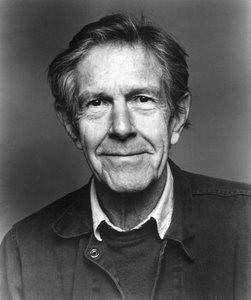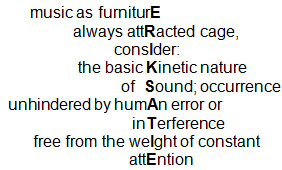JOHN CAGE

by Juilo Cann
(March 2013)
In order to begin to understand this genius polymath, one of the most influential figures of 20th century avant-garde, it is perhaps most useful to approach his work not in chronological order, which would only serve to elucidate his penchant for constant reinvention, but instead to delve into it as he did: from all directions simultaneously, and to try to find - or at least experience - the common aesthetic thread running through all of it. Therefore, in Cagean spirit, the following is a series of aleatoric impressions of the ideas and music of John Cage.

“Even variation is a form of repetition.” - Arnold Schoenberg.Although never a serialist, Cage was a true heir to the modernist ideals of his one-time teacher, Arnold Schoenberg. Tired of the exceeding expressiveness of Romantic music, he recognized the need to break free from the constrictions of European theories of harmony, melody, and arrangement. Like Schoenberg, he sought to use form to liberate composition from personal involvement. Their ideological approaches, however, were diametrically opposed: while Schoenberg proposed building strict artificial structures to force new sonorities into being, Cage attempted to create frameworks in which natural structures could manifest themselves. In this way he was a precursor to the field of generative music.“Repetition is a form of change.” - Brian Eno.
“Percussion music is a contemporary transition from keyboard-influenced music to the all-sound music of the future.” - John CageJohn Cage - along with Edgard Varèse - was one of the first in the Classical tradition to write for percussion ensemble. Furthermore, his arrangements included not only canonical instruments but also everyday objects, or demanded that string instruments and pianos be banged on as percussion. This experimentation culminated with his invention of the prepared piano, which called for nails and other objects to be inserted into the strings. It was his firm conviction that very soon, electronic technology would put every possible sound in the hands of the composer. He demanded the reclassification of music from “organized notes” to “organized sound,” a concept that was curiously rejected by Varèse but eagerly explored by successors of Cage such as Frank Zappa and made its way into the realm of sound designers, where Gary Rydstrom considers Cage “one of his greatest influences.”
“In the beginner’s mind there are many possibilities, in the expert’s there are few.” - Shunryu Suzuki.One of Cage’s most important contributions to contemporary classical music was his pioneering use of chance techniques to determine elements of composition. This attempt to turn away from personal taste and expression found a parallel in his study of Zen Buddhism, a discipline based on transcending the ego. A lifelong interest in Oriental thought brought him the I Ching, an ancient Chinese book of hexagrams which the composer often used as a tool for generating random events. Although highly influential, his aleatoric techniques also generated contempt from European former allies and friends, Pierre Boulez and Karlheinz Stockhausen. Critics claimed that Cage “abrogated his duty as a composer,” and reflected his own reluctance to making decisions. The composer retorted remarking that Boulez and Stockhausen also used chance-controlled techniques - albeit to a lesser extent - and complained that “it has to be his [Boulez’s] kind of chance.”“I try over and over to begin all over again.” - John Cage.
“Artists who use disciplines that free their work from their intentions start the flow moving in an outgoing direction.” - John Cage.Sensitive to the cultural environment of the ‘60’s, Cage turned his mind from pure art towards politics, and was especially influenced by the communism of Mao and the anarchism of Henry David Thoreau as well as his friends Buckminster Fuller and Marshall McLuhan. He believed that music could be a force for social change as long as the work embodied, rather than preached, the ideals it sought to communicate. Ever the optimist, Cage realized a multimedia piece in the vein of Fluxus, called HPSCHD and incorporating five harpsichords, a computer, dozens of pieces of artwork, costumes, performance, dance and video. The happening lasted an entire day and was attended by thousands of people, in an uncharacteristic moment that brought Cage as close to the hippie counterculture as he ever got.
A colorful character in New York’s bohemian culture, Cage’s social life included some of the most notorious artists, musicians, and thinkers of the 20th century. Kenneth Silverman’s biography suggests a four-way sexual encounter with Max Ernst, Marcel Duchamp and Peggy Guggenheim before he divorced his wife and embarked on a 40-year personal and professional relationship with Merce Cunningham. Other anecdotes include cooking Mexican dessert for neighbors John Lennon and Yoko Ono and mediating the split between Robert Rauschenberg and Jasper Johns. Perhaps most importantly, he is considered the founder of the New York School of composers, which included Morton Feldman, Earle Browne, Christian Wolff and the recipient of Cage’s unrequited love, David Tudor.
Influenced by his strict musical education, Cage always put great emphasis on the discipline of notation. He encouraged Morton Feldman to consider his manuscripts works of art in themselves, and together the two composers developed the idea of graphic scores.
John Cage’s figure remains omnipresent in the 21st century avant-garde, standing crucially at the passage between the transcendental project of Modernism and the more open-ended and pluralistic tendencies of Postmodernism. Though he remains a marginal character to the average non-classical music listener, the philosophical groundwork he laid is decisively felt in mainstream pop music through the attention given to timbre and sonic exploration. Alternative rock icons such as Sonic Youth and David Byrne have variously recorded and performed his work.
Always fond of paradoxes, Cage’s theory is not without its contradictions: the intention of non-intention, the politics of sound-in-itself. His attempts to undermine the influence of the composer in the content are now recognized as a distinct Cagean aesthetic. Until these points of contention are resolved or rendered irrelevant, the full implications of John Cage’s work and thought are yet to be fully absorbed.